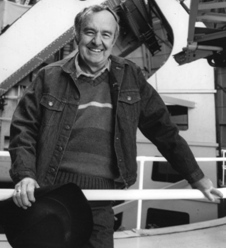- 1610: Galileo
- 1676: Ole Rømer
- 1687: Isaac Newton
- 1781: William Herschel
- 1838: Friedrich Bessel
- 1861: William and Margaret Huggins
- 1912: Henrietta Leavitt
- 1917 Einstein
- 1920: Harlow Shapley
- 1929 Edwin Hubble
- 1948: Ralph Alpher
- 1949: Fred Hoyle
- 1963: Maarten Schmidt
- 1964: Arno Penzias and Robert Wilson
- 1978: Vera Rubin and Kent Ford
- 1989: Margaret Geller and John Huchra
- 1992: John Mather and George Smoot
- 1995: Robert Williams
- 1998: Saul Perlmutter and Brian Schmidt
- 2010: Wendy Freedman
Alan Sandage
 |
| Alan Sandage. Image courtesy of the Observatories of the Carnegie Institution for Science. |
Cepheid variable stars could not be seen in distant galaxies so a different method was used to measure their distance. The brightest stars in nearby galaxies were assumed to be as bright as the brightest stars in the more distant galaxies. Then the inverse square law was used to estimate the distance to the further galaxies. Using the 200-inch telescope on Mount Palomar Alan Sandage found that the brightest objects in the distant galaxies were not stars at all, but very bright nebulae. That meant that the distant galaxies were much further away that they had been thought to be. The work by Sandage and others eventually pushed back the distances to the furthest galaxies, and the age of the universe to 10 to 20 billion years—perfectly reasonable to contain an Earth whose age has recently been estimated to be about 4.7 billion years.